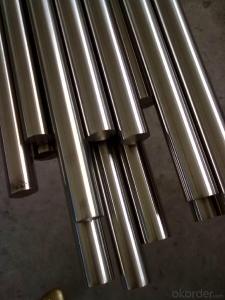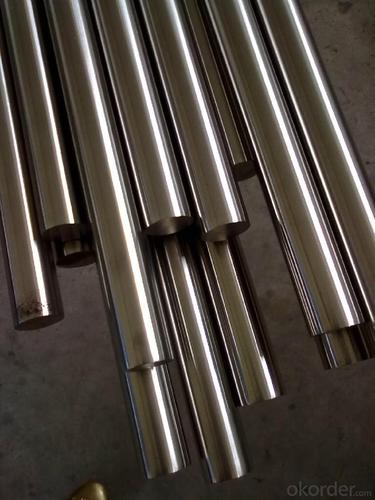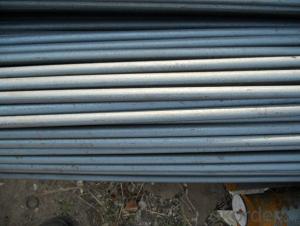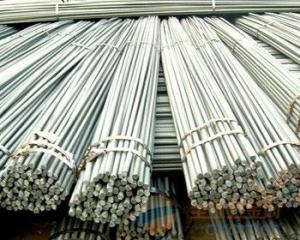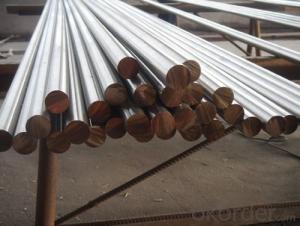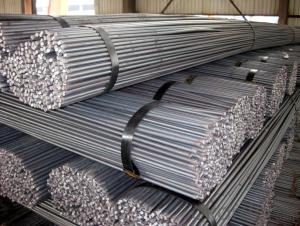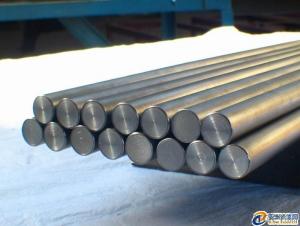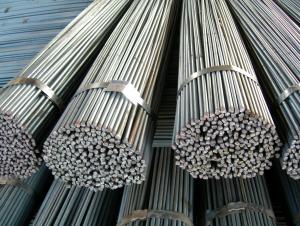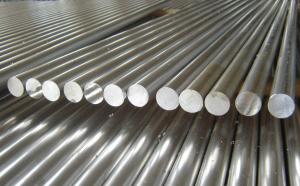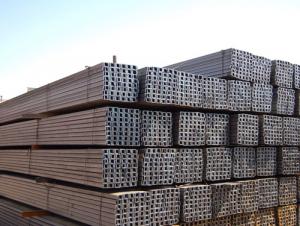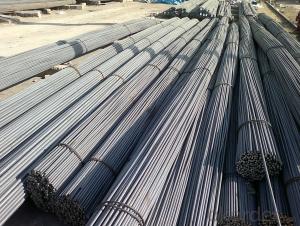Round Bar High Quality Q195 Q235 5MM-28MM Hot Rolled
- Loading Port:
- China Main Port
- Payment Terms:
- TT or LC
- Min Order Qty:
- -
- Supply Capability:
- -
OKorder Service Pledge
OKorder Financial Service
You Might Also Like
Product Description:
OKorder is offering high quality Round Bar High Quality Q195 Q235 5MM-28MM Hot Rolledat great prices with worldwide shipping. Our supplier is a world-class manufacturer of steel, with our products utilized the world over. OKorder annually supplies products to European, North American and Asian markets. We provide quotations within 24 hours of receiving an inquiry and guarantee competitive prices.
Product Applications:
1) Suitable for making various strong cutting tool abrasion resistance, impact resistance.
2) Used to produce all kinds of high hard and super hard saw blade, drill, tap, broach, gear hob and various kinds of milling cutter.
3) Used for advanced punching die, screw die, and the toughness and complicated shape of the punch, etc.
4) Is used for cold forging die and drawing mode, etc.
5) Recommended watchcase factory, screw factory and other cold stamping products industry use.
Product Advantages:
OKorder's Round Bar High Quality Q195 Q235 5MM-28MM Hot Rolledare durable, strong, and resist corrosion.
Main Product Features:
· Premium quality
· Prompt delivery & seaworthy packing (30 days after receiving deposit)
· Corrosion resistance
· Can be recycled and reused
· Mill test certification
· Professional Service
· Competitive pricing
Product Specifications:
1. Grade: GB, JIS, ASTM, EN
2. Grade: Q235, SS400, A36, S235JR
3. Diameter and mass: As below
Diameter | Mass | Diameter | Mass | Diameter | Mass |
(mm) | (kg/m) | (mm) | (kg/m) | (mm) | (kg/m) |
6 | 0.22 | 22 | 2.98 | 53 | 17.30 |
7 | 0.30 | 24 | 3.55 | 56 | 19.30 |
8 | 0.40 | 25 | 3.85 | 60 | 22.20 |
9 | 0.50 | 26 | 4.17 | 63 | 24.50 |
10 | 0.62 | 28 | 4.83 | 65 | 26.00 |
11 | 0.75 | 30 | 5.55 | 70 | 30.20 |
12 | 0.89 | 32 | 6.31 | 75 | 34.70 |
13 | 1.04 | 34 | 7.13 | 80 | 39.50 |
14 | 1.21 | 36 | 7.99 | 85 | 44.50 |
15 | 1.39 | 38 | 8.90 | 90 | 49.90 |
16 | 1.58 | 40 | 9.86 | 95 | 55.60 |
17 | 1.78 | 42 | 10.90 | 100 | 61.70 |
18 | 2.00 | 45 | 12.50 | 120 | 88.85 |
19 | 2.23 | 48 | 14.20 | 140 | 120.93 |
20 | 2.47 | 50 | 15.40 | 150 | 138.82 |
4. Material: Mild Steel
5. Heat treatment of high quality steel:
Fire: Isothermal annealing temperature is 800 ~ 880 °C, with 10 ~ 20 °C, the furnace cooling to about 600 °C, hardness above HB269.
Preheat temperature: 730-730 °C
Quenching temperature: 1190-1210 °C
Tempering temperature: 540-595 °C
Cold drawn, hardness 285 HBS
Cold drawn after annealing condition, hardness 277 HBS
Quenching methods: oil quenching, air cooling or salt bath quenching
FAQ:
Q1: Why buy Materials & Equipment from OKorder.com?
A1: All products offered byOKorder.com are carefully selected from China's most reliable manufacturing enterprises. Through its ISO certifications, OKorder.com adheres to the highest standards and a commitment to supply chain safety and customer satisfaction.
Q2: How do we guarantee the quality of our products?
A2: We have established an advanced quality management system which conducts strict quality tests at every step, from raw materials to the final product. At the same time, we provide extensive follow-up service assurances as required.
Q3: How soon can we receive the product after purchase?
A3: Within three days of placing an order, we will begin production. The specific shipping date is dependent upon international and government factors, but is typically 7 to 10 workdays.
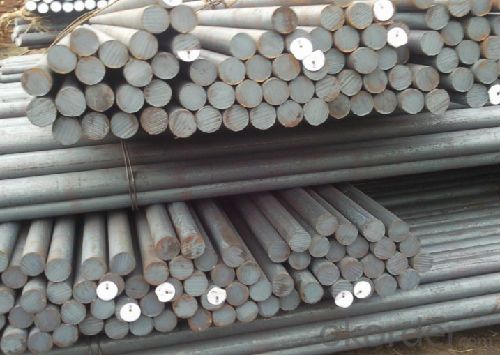
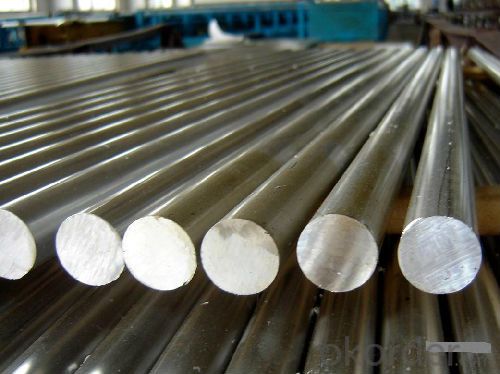
- Q: Is yuan steel round steel?
- 3 strength, steel and other steel with high strength low strength, namely, diameter of the same size as compared with other steel, round steel can bear the pulling force than other reinforced small, but the plastic steel reinforced bar is stronger than the other, there is a large deformation in the break before, and it reinforced the deformation the break before the much smaller.
- Q: How do you determine the strength of a steel round bar?
- The strength of a steel round bar can be determined through various methods, but the most common approach is by conducting a tensile test. This test involves applying a controlled force to the bar until it fractures, allowing for the measurement of its ultimate tensile strength (UTS). Other important parameters, such as yield strength, elongation, and reduction in area, can also be determined from the test results. Additionally, the chemical composition and microstructure of the steel can provide valuable insights into its overall strength and performance characteristics.
- Q: What are the different types of steel round bar surface treatments for improved hardness?
- There are several different types of steel round bar surface treatments that can be used to improve hardness. Some common treatments include case hardening, nitriding, and induction hardening. Case hardening involves adding carbon to the surface of the steel to create a hardened outer layer, while nitriding involves introducing nitrogen to form a hard nitride layer. Induction hardening uses heat to quickly heat and cool the surface of the steel, creating a hardened layer. These treatments can significantly enhance the hardness and wear resistance of steel round bars.
- Q: What are the different surface finishes available for steel round bars?
- There are several different surface finishes available for steel round bars, including hot rolled, cold drawn, polished, turned, and ground.
- Q: Can steel round bars be used for making shock absorber components?
- Yes, steel round bars can be used for making shock absorber components. Steel is a common material used in the manufacturing of shock absorbers due to its strength, durability, and resistance to wear and tear. Steel round bars can be machined or forged into various components of a shock absorber, such as piston rods, mounting brackets, or tube bodies. The use of steel ensures that these components can withstand the high pressures and forces associated with shock absorption, providing stability and smooth operation for the vehicle.
- Q: How do you calculate the weight of a steel round bar based on its density and dimensions?
- In order to determine the weight of a steel round bar, one must possess knowledge of its density and dimensions. The weight can be calculated using the formula W = V x D, where W represents weight, V represents volume, and D represents density. Firstly, it is necessary to ascertain the volume of the round bar. The volume of a cylinder can be calculated using the formula V = πr^2h, where V represents volume, π is a constant (approximately 3.14159), r represents the radius of the round bar, and h represents the height or length of the round bar. In the event that one possesses the diameter of the round bar instead of the radius, the radius can be determined by dividing the diameter by 2. Once the radius is determined, it can be substituted into the formula along with the height of the round bar to calculate the volume. Subsequently, knowledge of the density of the steel is required. The density of steel is typically measured in grams per cubic centimeter (g/cm^3) or kilograms per cubic meter (kg/m^3). It is imperative to ensure that the units for both density and volume are consistent. If the density is given in g/cm^3, the volume must be converted from cm^3 to m^3 by dividing it by 1,000,000. Finally, the weight can be calculated by multiplying the volume by the density. If the density is provided in kg/m^3, the weight will be in kilograms. If the density is provided in g/cm^3, the weight will be in grams. Conversion to other units can be achieved by utilizing appropriate conversion factors. It is crucial to verify all calculations and maintain consistency of units throughout the entire calculation process.
- Q: Can steel round bars be coated with protective finishes?
- Yes, steel round bars can be coated with protective finishes. Coating steel round bars with protective finishes is a common practice to enhance their durability and resistance to corrosion. There are various types of protective finishes that can be applied to steel round bars, including but not limited to galvanizing, powder coating, and epoxy coating. These finishes help to prevent the steel bars from rusting and deteriorating over time, extending their lifespan and ensuring their performance in various environments. The choice of protective finish depends on factors such as the intended use of the steel round bars, the level of exposure to moisture or corrosive substances, and the desired aesthetic appearance.
- Q: Can steel round bars be used for making transmission towers?
- Yes, steel round bars can be used for making transmission towers. Steel round bars are strong, durable, and have excellent load-bearing capabilities, making them suitable for supporting the weight and structure of transmission towers.
- Q: What is the difference between a solid and a hollow steel round bar?
- A cylindrical bar made entirely of solid steel material is called a solid steel round bar. It is completely filled and does not have any empty spaces inside. On the other hand, a hollow steel round bar is also cylindrical but has a hollow center, meaning there is empty space or a void within the bar. The primary distinction between a solid and a hollow steel round bar is their structural composition and the roles they fulfill. A solid steel round bar is typically used in applications where strength and durability are of utmost importance. It is commonly employed in construction, manufacturing, and engineering projects that require load-bearing capacity. Conversely, a hollow steel round bar is designed to be lighter in weight while still maintaining structural integrity. The hollow center allows for weight reduction while still providing sufficient strength for various applications. Hollow steel round bars are often utilized in industries such as aerospace, automotive, and marine, where reducing weight is crucial for enhanced fuel efficiency and overall performance. Furthermore, the empty space inside a hollow steel round bar also presents an opportunity for customization. It can be utilized to house other components, such as wires or piping, enabling a more streamlined and efficient design. This versatility makes hollow steel round bars suitable for various applications that necessitate both strength and weight reduction. In conclusion, the main difference between a solid and a hollow steel round bar lies in their structural composition and the roles they fulfill. Solid steel round bars are employed in applications that demand maximum strength and durability, while hollow steel round bars offer weight reduction and customization options, making them suitable for applications that prioritize lightweight design without compromising structural integrity.
- Q: What is the maximum nickel content allowed for steel round bars?
- The nickel content permitted for steel round bars can vary depending on the specific steel grade and application. Adding nickel to steel generally improves its mechanical properties, such as strength and toughness. However, excessively high nickel content can negatively affect the weldability and machinability of steel. As a result, industry standards and specifications often establish the maximum allowable nickel content for different grades of steel round bars. To determine the specific maximum nickel content allowed for a particular steel grade, it is essential to consult relevant standards and specifications, such as ASTM, AISI, or ISO. These standards offer comprehensive guidelines and restrictions to ensure the quality and suitability of steel round bars for a wide range of applications.
Send your message to us
Round Bar High Quality Q195 Q235 5MM-28MM Hot Rolled
- Loading Port:
- China Main Port
- Payment Terms:
- TT or LC
- Min Order Qty:
- -
- Supply Capability:
- -
OKorder Service Pledge
OKorder Financial Service
Similar products
Hot products
Hot Searches
